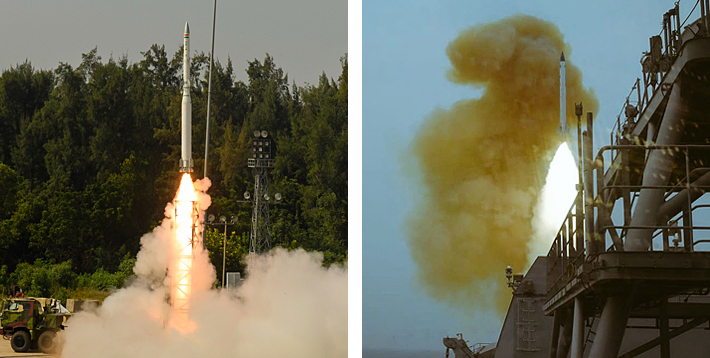INDIAN ARMED FORCES CHIEFS ON OUR RELENTLESS AND FOCUSED PUBLISHING EFFORTS

The insightful articles, inspiring narrations and analytical perspectives presented by the Editorial Team, establish an alluring connect with the reader. My compliments and best wishes to SP Guide Publications.

"Over the past 60 years, the growth of SP Guide Publications has mirrored the rising stature of Indian Navy. Its well-researched and informative magazines on Defence and Aerospace sector have served to shape an educated opinion of our military personnel, policy makers and the public alike. I wish SP's Publication team continued success, fair winds and following seas in all future endeavour!"

Since, its inception in 1964, SP Guide Publications has consistently demonstrated commitment to high-quality journalism in the aerospace and defence sectors, earning a well-deserved reputation as Asia's largest media house in this domain. I wish SP Guide Publications continued success in its pursuit of excellence.
Space-Based Surveillance (SBS) & BMD
The SBS-III project, costing ₹26,968 crore, is expected to be completed in a decade and will provide dedicated surveillance capabilities for India's armed forces across land, sea, and air.
 |
The Author is Former Director General of Information Systems and A Special Forces Veteran, Indian Army |

On October 8, 2024, the Cabinet Committee on Security (CCS), headed by Prime Minister Narendra Modi approved phase III of the Space Based Surveillance (SBS-III), which involves launching 52 satellites. These satellites, enhanced with artificial intelligence (AI), will bolster India's surveillance capabilities, especially along borders with Pakistan and China, as well as in the maritime domain.
SBS 1 was initiated by the Vajpayee government in 2001, and involved the launch of four satellites for surveillance, Cartosat 2A, Cartosat 2B, Eros B and Risat 2. SBS 2 came in 2013 with the launch of six satellites, Cartosat 2C, Cartosat 2D, Cartosat 3A, Cartosat 3B, Microsat 1 and Risat 2A.
On October 8, 2024, the Cabinet Committee on Security (CCS) approved phase III of the Space-Based Surveillance (SBS-III) project, involving the launch of 52 satellites enhanced with artificial intelligence (AI).
SBS-III is handled by the National Security Council Secretariat (NSCS) along with the Defence Space Agency (DSA) under the integrated headquarters in the defence ministry. The project involves the launch of 52 satellites in Low Earth Orbit (LEO) and Geo-stationary Orbit (GEO) for surveillance. Construction and launch of 21 satellites will be by the Indian Space Research Organisation (ISRO) and the remaining 31 satellites will be done by private companies.
ISRO has said that these new satellites will utilise AI, will be able to interact with each other and thus gather GeoIntelligence more effectively. This implies that a satellite at a 36,000 km altitude detects something of interest on the ground, it can ask another satellite in the lower orbit to check it more carefully and then give the base station this information.

The project cost of SBS-III is pegged at ₹26,968 crore and it is reportedly to be completed in a decade. This will provide the Indian Armed Forces dedicated satellites for their land, sea and air-based missions. In January 2024, India signed a letter of intent with France for the joint construction and launch of military satellites. In addition, India has recently signed a $4 billion deal with the US for procuring 31 Predator armed drones from US based General Atomics. These will boost the surveillance and kill capabilities of the Armed Forces.
The SBS-III satellites will operate in Low Earth Orbit (LEO) and Geostationary Orbit (GEO), with 21 constructed by ISRO and the remaining 31 by private companies, enabling advanced GeoIntelligence capabilities.
India's focus is to acquire capabilities which can detect enemy submarines in the Indo-Pacific as well as track infrastructure construction by its adversaries along and astride the land and sea borders. SBS-III will be a game changer, providing round-the-clock Earth Observation capabilities that will be unaffected by weather and daytime. This will enable exercising proactive defence and taking timely action against any contingencies arising.
Earlier on July 24, 2024, the Defence Research and Development Organisation (DRDO) successfully flight-tested Phase-II of the Ballistic Missile Defence (BMD) System. The target missile was launched from LC-IV 'Dhamra' at 1620 hours mimicking an adversary ballistic missile, which was detected by weapon system radars deployed on land and sea and activated the air defence (AD) Interceptor system.

(Right) DRDO & Indian Navy Conduct Successful Trial of BMD Interceptor from Naval Platform.
The Phase-II AD endo-atmospheric missile is an indigenously developed two-stage solid propelled ground launched missile system meant for neutralising many types of enemy ballistic missile threats in the altitude bracket of endo to low exo-atmospheric regions. Multiple indigenous technologies developed by various DRDO laboratories have been incorporated in the missile system.
The Phase-II AD endo-atmospheric missile was launched from LC-III in ITR, Chandipur. The flight test fully met all the trial objectives validating a complete network centric warfare (NCW) weapon system consisting of long-range sensors, low latency communication system and MCC and Advance Interceptor missiles.
On July 24, 2024, DRDO successfully tested Phase-II of the Ballistic Missile Defence (BMD) System, demonstrating India's capability to intercept ballistic missiles in the 5,000-km class.
The performance of the missile was monitored from the flight data captured by range tracking instruments like electro-optical systems, radar and telemetry stations deployed by ITR, Chandipur at various locations including on-board ship. The test demonstrated India's capability to defend against ballistic missiles of 5,000-km class.
Defence Minister Rajnath Singh complimented the DRDO for the successful flight test and stated that it has again demonstrated the Ballistic Missiles Defence capability. Secretary Department of Defence R&D and Chairman DRDO Samir V. Kamat congratulated the entire DRDO team for their untiring effort and contribution culminating into the successful flight test.





